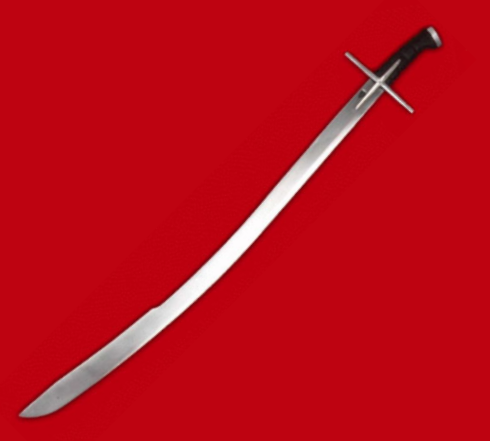
 |
|
|
|
|
#1 |
|
Member
Join Date: Dec 2004
Location: Ann Arbor, MI
Posts: 5,503
|
Just ended
http://cgi.ebay.com/ws/eBayISAPI.dll...MEWA:IT&ih=019 The blade carries Indian armoury markings ( Ulwar?) but nothing of Polish connection and the handle, including the leather, is gloriously intact. Any explanations? |
|
|

|
|
|
#2 |
|
Member
Join Date: Mar 2006
Location: Room 101, Glos. UK
Posts: 4,183
|
that 'karabela' looks almost exactly like the Viktor Berbekucz made 16c hungarian sabre i have, it was custom forged by him a couple years ago out of CV steel and has a modern molded grip, and does not have a channeled and marked spine, just his VB sheild logo near the languet.
 his catalogue photo:  his website appears to be down, but normally resides at http://www.berbekuczviktor.hu/ i believe he has based his designs on one of the exhibits at a hungarian nat'l. museum. the blade on the ebay one looks more tulwarish, the grip looks much like my VB one except mine is not grooved under the languet, and is grooved from the languet's lower end to the pommel. the ebay one has an unsharpened tulwarry ricasso, less well defined yelman; mine is sharp to the guard. looks like an indian fitted a hungarian grip and guard to a tulwar blade (or visa versa) to the 'polish' ebay sword. the grip doesn't look very karabela-like to my untrained eyes....but what do i know, maybe a polish lordlet imported an austo-hungarian swordsmith of a distinguished indian ancestry who was a ex-armory blade marker who got nostalgic. Last edited by kronckew; 24th July 2007 at 07:58 AM. |
|
|

|
|
|
#3 |
|
Member
Join Date: Dec 2004
Location: Poland, Krakow
Posts: 418
|
Of course it isn't karabela, and the name used for it was more like marketing concept to attract people. The proper name for this sword is Hungarian-Polish type of course, while many of these were used in both countries. Sabres like that one, used in Poland (up to the half of the 17th century, then it started to disappear, thought in Hungary last a little longer with some later variations) were usually mounted with blades from Genoa or made as Genoa blades, with characteristic 'sickles" stamps, thought of course you can find many other blades from Germany or made in Poland (probably) too.
This one (I'm sorry I'll be sincere) looks very fake to me. Leather it too new, the hilt is too heavy and clumsy. Even the steel, as far as I can conclude from the pictures, doesn't look ancient at all. Fake handle would be an answer for an eastern blade, attached to it just because it does look nice  - my opinion. - my opinion. I wouldn't like to discourage every Polish-arms lover but please beware, because there are many fakes of Hungarian-Polish sabres on auctions lately. Through many years there was a lack of these sabres and immediately some of the auction houses started to sell those sabres in many pieces - while no new historical source appeared! So it is suspected already! I have to admit that I had in my hands quite a good copy recently too. With such grip, but very long and heavy blade, straight one, so it was a pallash. It was very good, and I thought about it few days with other people to find all evidences for it to be a fake. The blade was probably old, refitted to newer, Hungarian-Polish type handle, very heavy and bigger then usual, also with a hilt made like that one on ebay (thought a little better). So maybe some pictures of real sabres for you  : :
|
|
|

|
|
|
#4 |
|
Member
Join Date: Sep 2006
Location: Poland
Posts: 80
|
I totally agree with Michal, the blade is from tulwar and the handle is very recent work, poorly done. There are some... polish hungarian swords on the market here in Poland and it seems that part of those went for a trip to USA

|
|
|

|
|
|
#5 |
|
Member
Join Date: Dec 2004
Location: Greensboro, NC
Posts: 1,083
|
I remember this sword at the Baltimore show earlier this year and had a chance to handle it. The blade is Indian and is an old blade. By old, I mean 18th or 19th century. You can see the armoury markings on the spine. Notice also the typical Indian ricasso at the forte. You have the interesting "channeled" spine which is not common but is found on some Indian, Chinese and E European blades. The blade has genuine wear throughout. The hilt, however, is another matter. As you can see from one of the pictures, the vertical guard still has a lot of tooling marks. They look a bit clumsy to me and somewhat crude. The leather is fairly nicely done but does not show a lot of genuine age. So, a composite piece of antique blade with newer handle of unknown age but almost certainly 20th century.
|
|
|

|
|
|
#6 |
|
Member
Join Date: Dec 2004
Location: Ann Arbor, MI
Posts: 5,503
|
In my original posting I purposefully tried to sound neutral.
I am sure it is a hybrid sword, with old Indian blade and new "Polish-Hungarian"- type handle and crossguard. |
|
|

|
|
|
#7 |
|
Member
Join Date: Jun 2007
Location: Lower Silesia, Poland
Posts: 9
|
It's fake in my opinion. Agree with Wolview. The leather too new, crossguard as well, no rivets, etc. Even shape of this sabre does not convince me.
|
|
|

|
 |
|
|